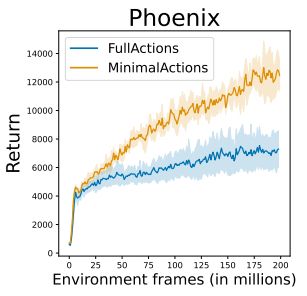
https://psc-g.github.io/
I argue they should be:
🔵 well-understood
🔵 diverse & without experimenter-bias
🔵 naturally extendable
Under this lens, the ALE is still a useful benchmark for RL research, *when used properly* (i.e. to advance science, rather than "winning").
14/X

I argue they should be:
🔵 well-understood
🔵 diverse & without experimenter-bias
🔵 naturally extendable
Under this lens, the ALE is still a useful benchmark for RL research, *when used properly* (i.e. to advance science, rather than "winning").
14/X
When reporting aggregate performance (like IQM), the choice of games subset can have a huge impact on algo comparisons (see figure below)!
We're missing the trees for the forest!🌳
🛑Stop focusing on aggregate results, & opt for per-game analyses!🛑
13/X


When reporting aggregate performance (like IQM), the choice of games subset can have a huge impact on algo comparisons (see figure below)!
We're missing the trees for the forest!🌳
🛑Stop focusing on aggregate results, & opt for per-game analyses!🛑
13/X
When ALE was introduced, Bellemare et al. recommended using 5 games for hparam tuning, & a separate set of games for eval.
This practice is no longer common, and people often use the same set of games for train/eval.
If possible, make them disjoint!
12/X

When ALE was introduced, Bellemare et al. recommended using 5 games for hparam tuning, & a separate set of games for eval.
This practice is no longer common, and people often use the same set of games for train/eval.
If possible, make them disjoint!
12/X
While 200M env frames was the standard set by Mnih et al, now there's a wide variety of lengths used (100k, 500k, 10M, 40M, etc.). In arxiv.org/abs/2406.17523 we showed exp length can have a huge impact on conclusions drawn (see first image).
11/X


While 200M env frames was the standard set by Mnih et al, now there's a wide variety of lengths used (100k, 500k, 10M, 40M, etc.). In arxiv.org/abs/2406.17523 we showed exp length can have a huge impact on conclusions drawn (see first image).
11/X
ɣ is central to training RL agents, but on the ALE we report undiscounted returns:
👉🏾We're evaluating algo's using a different objective than what they were trained for!👈🏾
To avoid ambiguity, we should report {ɣ_train} and ɣ_eval.
10/X

ɣ is central to training RL agents, but on the ALE we report undiscounted returns:
👉🏾We're evaluating algo's using a different objective than what they were trained for!👈🏾
To avoid ambiguity, we should report {ɣ_train} and ɣ_eval.
10/X
Given that we're dealing with a POMDP, state transitions are between Atari RAM states, & observations are affected by all the software wrappers.
Design decisions like whether end-of-life means end-of-episode affects transition dynamics & performance!
8/X

Given that we're dealing with a POMDP, state transitions are between Atari RAM states, & observations are affected by all the software wrappers.
Design decisions like whether end-of-life means end-of-episode affects transition dynamics & performance!
8/X
In the ALE you can use a "minimal set" or the full set, & you see both being used in the literature.
This choice matters a ton, but you don't always see it stated explicitly!
5/X

In the ALE you can use a "minimal set" or the full set, & you see both being used in the literature.
This choice matters a ton, but you don't always see it stated explicitly!
5/X
Nope, single Atari frames are not Markovian => for Markovian policies, design choices like frame skipping/stacking & max-pooling were taken.
*This means we're dealing with a POMDP!*
And these choices matter a ton (see image below)!
4/X

Nope, single Atari frames are not Markovian => for Markovian policies, design choices like frame skipping/stacking & max-pooling were taken.
*This means we're dealing with a POMDP!*
And these choices matter a ton (see image below)!
4/X
Stella is the emulator of the Atari 2600, but we use the ALE as a wrapper around it, which comes with its own design decisions.
But typically we interact with something like Gymnasium/CleanRL on top of that.
3/X

Stella is the emulator of the Atari 2600, but we use the ALE as a wrapper around it, which comes with its own design decisions.
But typically we interact with something like Gymnasium/CleanRL on top of that.
3/X
However, we almost never *explicitly* map our MDP formalism to the envs we evaluate on! This creates a *formalism-implementation gap*!
2/X


However, we almost never *explicitly* map our MDP formalism to the envs we evaluate on! This creates a *formalism-implementation gap*!
2/X
Lots of progress in RL research over last 10 years, but too much performance-driven => overfitting to benchmarks (like the ALE).
1⃣ Let's advance science of RL
2⃣ Let's be explicit about how benchmarks map to formalism
1/X

Lots of progress in RL research over last 10 years, but too much performance-driven => overfitting to benchmarks (like the ALE).
1⃣ Let's advance science of RL
2⃣ Let's be explicit about how benchmarks map to formalism
1/X
We evaluated Flow Q-Learning in offline-to-online to online training as well as FastTD3 on multitask settings, and observe gains throughout.
9/X

We evaluated Flow Q-Learning in offline-to-online to online training as well as FastTD3 on multitask settings, and observe gains throughout.
9/X
No!
We evaluate on FastTD3-SimBaV2 and FastSAC on HumanoidBench, FastTD3 on Booster T1, as well as PPO on Atari-10 and IsaacGym and observe gains in all these settings.
8/X

No!
We evaluate on FastTD3-SimBaV2 and FastSAC on HumanoidBench, FastTD3 on Booster T1, as well as PPO on Atari-10 and IsaacGym and observe gains in all these settings.
8/X
No!
We ablate FastTD3 components and vary some of the training configurations and find that the addition of SEM results in improvements under all these settings, suggesting its benefits are general.
7/X

No!
We ablate FastTD3 components and vary some of the training configurations and find that the addition of SEM results in improvements under all these settings, suggesting its benefits are general.
7/X
6/X

6/X
Our analyses show they increase effective rank of actor features while bounding their norms, have reduced losses, more consistency across critics, & sparser representations, ultimately resulting in improved performance and sample efficiency.
5/X


Our analyses show they increase effective rank of actor features while bounding their norms, have reduced losses, more consistency across critics, & sparser representations, ultimately resulting in improved performance and sample efficiency.
5/X
4/X


4/X
3/X

3/X
2/X
2/X
In our recent preprint we demonstrate that the use of well-structured representations (SEMs) can dramatically improve sample efficiency in RL agents.
1/X

In our recent preprint we demonstrate that the use of well-structured representations (SEMs) can dramatically improve sample efficiency in RL agents.
1/X






#trailrunpostconference




#trailrunpostconference
It was also so great getting the opportunity to see so many of my students shine while presenting and discussing their research!




It was also so great getting the opportunity to see so many of my students shine while presenting and discussing their research!

